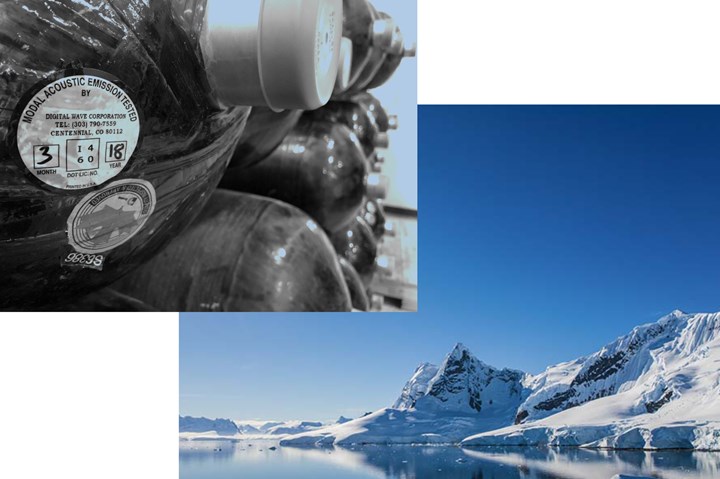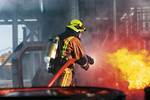Hexagon Digital Wave starts continued life service testing on composite cylinders for breathing apparatus
Tested tanks returned for extended service life with Antarctic Fire Department, prevents landfill on Antarctica continent.

Images compiled by CW.
Hexagon Digital Wave (Centennial, Colo., U.S.) was selected by the Antarctic Fire Department to perform continued service life testing on carbon fiber self-contained breathing apparatus cylinders (SCBA).
The Antarctic Fire Department is a support mechanism for the U.S Antarctic Program (USAP) and United States Air Force (USAF), and aids the advancement of world science by providing fire/rescue services in some of the most extreme conditions south of the 60° latitude. In addition to protecting USAP and USAF operations, the Antarctic Fire Department renders mutual-aid response to the volunteer fire brigade at New Zealand’s research station.
Managed and funded by the National Science Foundation (NSF, Alexandria, Virg., U.S.), the USAP operates out of three year-round bases, two research ships and multiple seasonal camps. As the representatives of the U.S. on the Antarctic Continent, supporting the Antarctic Treaty and conducting research are chief among the USAP’s responsibilities.
SCBA cylinders are typically transferred to landfills in North America once end of usable service life is reached. Naturally, they will not go through the decomposition process, but remain for future generations. To avoid discarding their cylinders, the Antarctic Fire Department started looking for a more sustainable solution.
In December 2020, using Special Permit 16320, Hexagon Digital Wave started the continued service life testing process on carbon fiber SCBAs for the Antarctic Fire Department. The testing process is now finalized, and the cylinders have been returned to the Antarctic Fire Department.
“We are honored to be chosen for this project. We believe in clean air everywhere and being able to provide sustainable solutions to those that are operating in one of the world’s most remote and untouched areas, is a great privilege,” says Jack Schimenti, president, Hexagon Digital Wave.
Hexagon Digital Wave says the cylinders, tested under DOT-SP 16320, will be the first continued service life carbon fiber cylinders used on the highest, driest, windiest and coldest continent on Earth: Antarctica.
Related Content
-
Aurora reveals latest SPRINT X-Plane design concept
An Aurora and Boeing team advances its high-speed, vertical lift concept to the preliminary design phase, which features three lift fans, a more refined composite exterior and an uncrewed cockpit.
-
Optimized approach to predict delamination failure in CFRTP structures
ARRK Engineering and Mitsui Chemicals improved delamination prediction accuracy to help optimize absorbed energy/failure load for an overmolded TAFNEX CF/PP UD tape bumper beam.
-
Improving carbon fiber SMC simulation for aerospace parts
Simutence and Engenuity demonstrate a virtual process chain enabling evaluation of process-induced fiber orientations for improved structural simulation and failure load prediction of a composite wing rib.
















